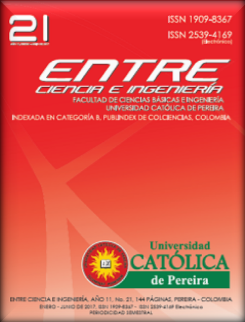Respirometric study of Diclofenac biodegradation
DOI:
https://doi.org/10.31908/19098367.3268Keywords:
biological degradation, diclofenac, pharmaceutical compounds, espirometry, wastewaterAbstract
Pseudo-persistent contaminants in wastewater, as pharmaceutical compounds, create a need to study different methods capable to degrade these contaminants in order to reduce its concentration in water sources and treatment plants, since they could generate some problems therein. The biological treatment is often the main treatment in these WWTP. In this study, the analysis of the biological degradation of a nonsteroidal anti-inflammatory, as diclofenac, was carried out using respirometric techniques. Different batch experiments were carried out in a respirometer LFS (liquid-flowstatic) type, with activated sludge from a local WWTP to determine the aerobic biodegradation of diclofenac. The initial concentration of diclofenac was in the range 5-100 mg/L. The degradation was analyzed by COD and OD measurements. The profile of OD consumption was obtained for all samples. Removals of 50% were obtained after 285 min of reaction. However, the aerobic degradation increased until 80% of pollutant removal after 24 hours of analysis.
It was observed that the activated sludge was able to consume the pollutant, however the reaction times were very long considering the requirements of the WWTP.
References
Kosma, C., Lambropoulou, D., & Albanis, T. (2014). Investigation of PPCPs in wastewater treatment plants in Greece: Occurrence, removal and environmental risk assessment. Science of the Total Environment 466-467, 421-438.
Ashton, D., Hilton, M., & Thomas, K. (2004). Investigating the transport of human pharmaceuticals to streams in the United Kingdom. Science of the Total Environment 333(1), 167-184.
Gómez, M.J., Martínez Bueno, M.J., Lacorte, S., Fernández-Alba, A.R., Agüera, A. (2007). Pilot survey monitoring pharmaceuticals and related compounds in a sewage treatment plant located on the Mediterranean coast. Chemosphere 66(6), 993-1002.
Kraigher, B., Kosjek, T., Heath, E., Kompare, B., & Mandic-Mulec, I. (2008). Influence of pharmaceutical residues on the structure of activated sludge bacterial communities in wastewater treatment bioreactors. Water Research 42(17), 4578-4588.
Carballa, M., Omil, F., Ternes, T., Lema J.M. (2007). Fate of pharmaceutical and personal care products (PPCPs) during anaerobic digestion of sewage sludge. Water Research 41, 2139–2150.
Christensen, F.M. (1998). Pharmaceuticals in the environment—a human risk? Regulatory Toxicology and Pharmacology 28(3), 212–221.
Quintana, J.B., Weiss, S., Reemtsma, T. (2005). Pathways and metabolites of microbial degradation of selected acidic pharmaceutical and their occurrence in municipal wastewater treated by a membrane bioreactor. Water Research 39(12), 2654-2664.
Kosjek, T., Heath, E., Petrovic, M., Barceló, D. (2007). Mass spectrometry for identifying pharmaceutical biotransformation products in the environment. TrAC Trends in Analytical Chemistry 26(11), 1076-1085.
Verlicchi, P., Galletti, A., Petrovic, M., Barceló, D., Al Aukidy, M., & Zambello, E. (2013). Removal of selected pharmaceuticals from domestic wastewater in an activated sludge system followed by a horizontal subsurface flow bed — Analysis of their respective contributions. Science of the Total Environment 454-455, 411-425.
Heberer, T. (2002). Occurrence, fate, and removal of pharmaceutical residues in. Toxicology Letters 131(1-2), 5-17.
Basnyat, P. (2011). Evaluation of toxicity of pharmaceuticals to the activated sludge treatment plant. Master of Science thesis. Tampare University of Technology, 72.
Zhang, Y., Geiben, S-Uwe y Gal, C (2008) Carbamazepine and Diclofenac: removal in wastewater treatment plants and occurrence in water bodies. Chemosphere 23, 1151-1161.
Vieno, N., Sillanpää, M. (2014). Fate of diclofenac in municipal wastewater treatment plant — A review. Environment International 69, 28-39.








 Revista Entre Ciencia e Ingeniería
Revista Entre Ciencia e Ingeniería .png) entrecei@ucp.edu.co
entrecei@ucp.edu.co.png) ISSN (Impreso) 1909-8367 - ISSN (En Línea) 2539-4169
ISSN (Impreso) 1909-8367 - ISSN (En Línea) 2539-4169 Attribution-NonCommercial 4.0 International (CC By-NC 4.0)
Attribution-NonCommercial 4.0 International (CC By-NC 4.0)
.png) Carrera 21 No. 49-95 Av. de las Américas, Pereira, Risaralda, Colombia
Carrera 21 No. 49-95 Av. de las Américas, Pereira, Risaralda, Colombia